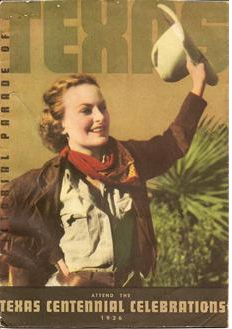Themes of the Centennial
During the Centennial, several themes emerged that were prominent not only in the murals, but in every aspect of the Centennial celebrations. From plays, publicity, literature and monuments, the four themes below helped Centennial leaders focus their efforts in defining Texas identity.
Transportation
For many Texans transportation was an integral part of the state’s identity. During the 1930’s, a number of public art projects, specifically murals, showcased transportation. As author Karel Ann Marling notes, the “mural saga of transportation across America was an object lesson to the ‘30’s.”4
Karel Ann Marling, Wall to Wall America: A Cultural History of Post-Office Murals in the Great Depression. Minneapolis: University of Minnesota Press, 1982. 138.
Transportation was a symbol of the American spirit, of how Americans could improve their situation by moving westward in automobiles and trains as their ancestors had done in stage-coaches. The theme was seen repeatedly in public art of the 1930’s, especially post office murals. The two most common motifs were airplanes and locomotive engines, although stage-coaches, automobiles, sailing vessels, and occasionally, blimps, were also painted. Transportation was specifically significant to a Texas audience. As historian Mark Busby observes, “traveling occurs naturally in a state as large as Texas.” Transportation was not only what brought Texas into contact with the rest of the nation, but was also an area that Texas saw itself a leader in.
The theme of transportation was emphasized throughout the state during the Centennial Celebration. As part of a plan to “market the state to newly developing automobile tourism,”5
Leigh Clemons, Branding Texas: Performing Culture in the Lone Star State. Austin: University of Texas Press, 2008,17.
driving tours were set up between cities in Texas, specifically Dallas and San Antonio. These tours encouraged visitors to the state to spread their attention (and money) with other parts of Texas, while stopping at some of the almost 600 historical landmarks marked along the way. In an address on the Centennial Exposition, Texas Congressman Luther A. Johnson explained that Texas’ “development of wealth could hardly have taken place if there had not gone with it a parallel development of transportation.”6
Texas Centennial Exhibition held at The Library of Congress, Washington D.C., December 15, 1945 – April 15, 1946. Washington: United States Government Printing Office, 1946, 7.
He went to on to explain the phases of Texas history in accord with various forms of transportation, discussing ships, railroads, stage-coach, the automobile, and aviation.
Industry was depicted in Pierre Bourdelle's murals for the Varied Industries building. Industry was perceived as helping to usher in a new era - automation, streamlining, advances in technology. Many new companies in Texas were involved in industry on a national level, and wanted to be seen as leaders of their industries.
Agriculture
While industry was of growing importance, Texas still had strong ties to agriculture. Thanks to the sprawling landscape and varying climates throughout Texas, a variety of crops are able to be grown in the state. Agriculture was also of special significance during the 1930's, as many viewed poor farming techniques and abuse of land to have contributed to the dust bowl and the Depression.
Race
This was a time in Texas history rife with racial turmoil as people attempted to define those who were true Texans (Anglos) and who were not Texans (Hispanics, blacks, Tejanos.) In a 1936 article anticipating the Centennial, Anne Birdwell explained that the Exposition, in addition to celebrating Texas’ independence, was meant to introduce the world to Texas, and to educate them on who Texans were. In discussing the legacy of the Texas Revolution, Birdwell noted that the essence of Texas’ independence was “the struggle between the Anglo-American and the Spanish-American, and the conflicting ideas of social relationships and political activities implied in the two terms…those who come to our birthday party will catch the spirit of this struggle.”7 A.W. Birdwell, “The Texas Centennial Exposition (Educationally Speaking).” Peabody Journal of Education, Vol. 13, No. 6 (May, 1936), pp. 278. This was evident in a number of aspects of the centennial, but perhaps none as visibly as the art work of the Exposition. Rather than portraying the diversity of Texas' population, Texas is represented by pairs of Caucasians.
4Karel Ann Marling, Wall to Wall America: A Cultural History of Post-Office Murals in the Great Depression. Minneapolis: University of Minnesota Press, 1982. 138.
5Leigh Clemons, Branding Texas: Performing Culture in the Lone Star State. Austin: University of Texas Press, 2008,17.
6Texas Centennial Exhibition held at The Library of Congress, Washington D.C., December 15, 1945 – April 15, 1946. Washington: United States Government Printing Office, 1946, 7.
7A.W. Birdwell, “The Texas Centennial Exposition (Educationally Speaking).” Peabody Journal of Education, Vol. 13, No. 6 (May, 1936), pp. 278.

